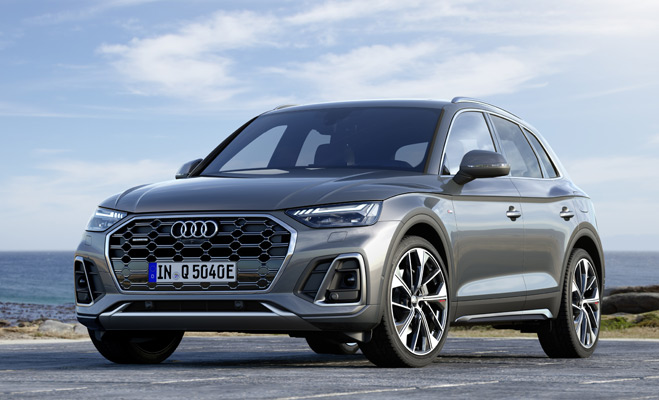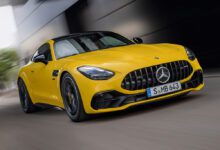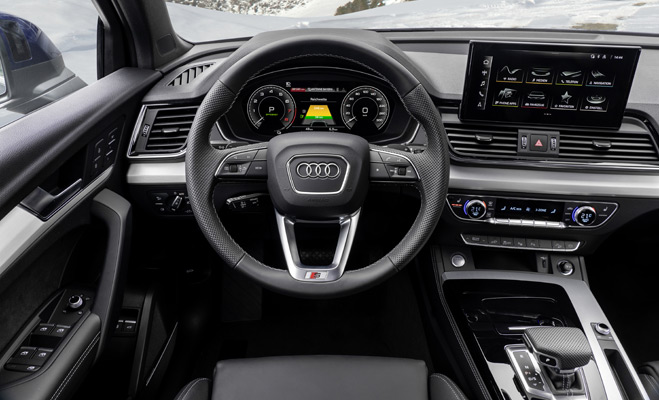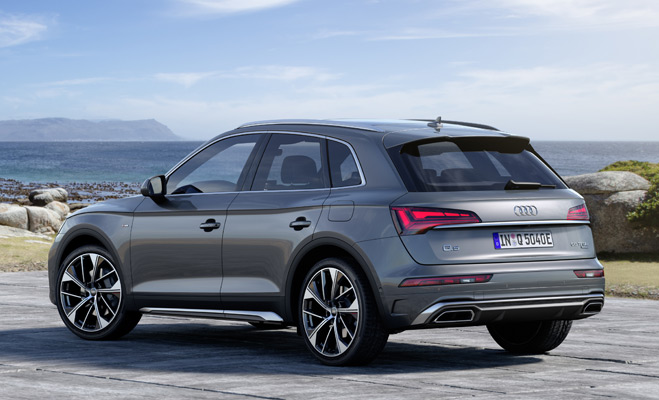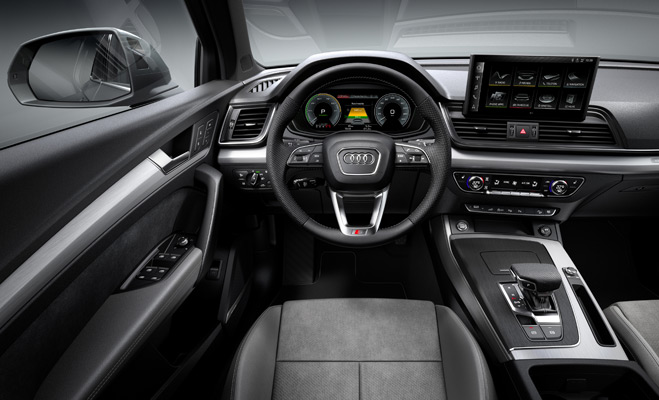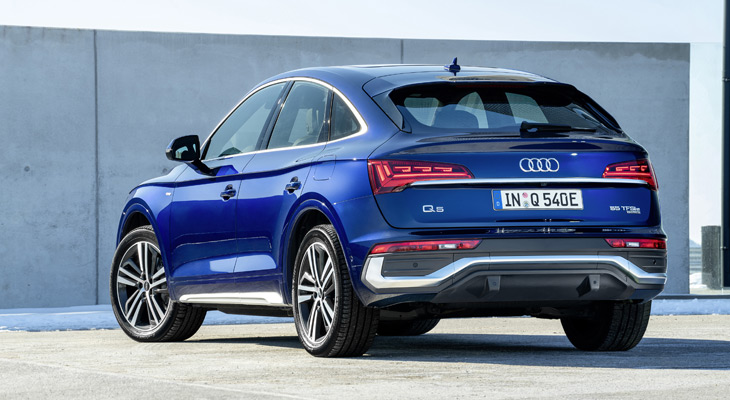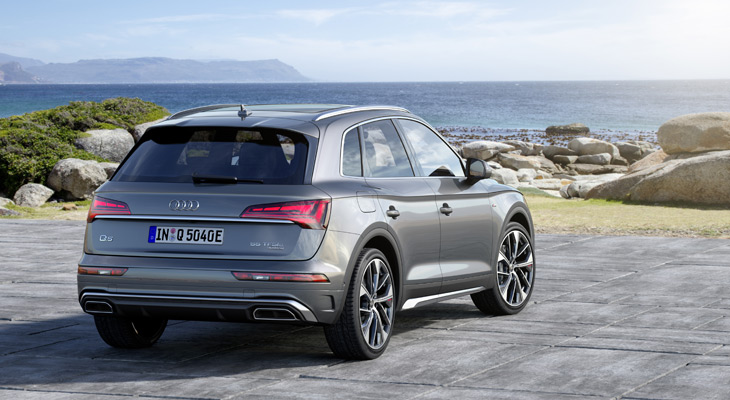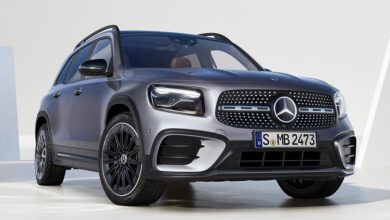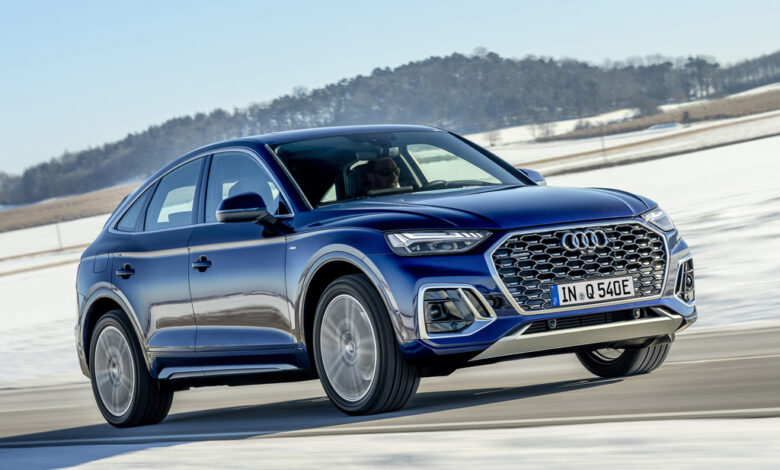
Audi Q5 Sportback TFSI e quattro
Audi is expanding its range of plug-in hybrid models with the launch of the Q5 Sportback TFSI e quattro for European markets. The elegant SUV coupe rolls off the assembly line in two versions: the Q5 Sportback 50 TFSI e quattro delivers 220 kW (299 hp) and the Q5 Sportback 55 TFSI e quattro delivers 270 kW (367 hp). In both models, the lithium-ion battery can store 14.4 kWh of usable energy, enough for a range of up to 61 km according to WLTP standards (71 km according to NEDC). Its sister model, the 2019 Audi Q5 TFSI e quattro, now features an even more powerful battery.
Sporty and elegant plug-in hybrid: Audi Q5 Sportback TFSI e quattro
The Q5 TFSI e quattro and Q5 Sportback TFSI e quattro models use the same transmission design in both power ratings. It consists of a 2.0 TFSI petrol engine with 195 kW (265 hp) and 370 Nm of torque coupled to an electric motor. The permanently excited synchronous motor (PSM) has a peak power of 105 kW and a maximum torque of 350 Nm. Together with the clutch, it is integrated into the seven-speed automatic transmission S tronic, which transmits torque to the quattro transmission with ultra technology. In normal driving, power is only sent to the front wheels for efficiency reasons. The rear axle connects instantly when needed.
The lithium-ion battery is located under the boot floor. The battery consists of 104 prismatic cells and at 381 V can store 14.4 kWh of energy (net; 17.9 kWh gross). To ensure optimum temperature, its refrigeration circuit is connected to both the refrigerant circuit of the air conditioner and to the low temperature circuit that feeds the electric motor and electronics. The air conditioning system is fitted as standard with a built-in high efficiency heat pump that captures the waste heat generated by high voltage components. It can generate up to 3 kW of thermal power from 1 kW of electricity, which improves the vehicle's energy efficiency and provides a more comfortable climate for passengers inside the vehicle.
Two power versions: 220 kW (299 HP) and 270 kW (367 HP)
Since the two versions of the engine have different boost strategies, they have different power and system torque. Q5 Sportback 50 TFSI e quattro (Combined fuel consumption in l/100 km: 2.0-1.8; Electricity consumption combined in kWh/100 km: 19.6-19.3; Combined CO2 emissions , g/km: 45–42) with 220 kW (299 hp) and 450 Nm of torque, accelerates from 0 to 100 km/h in 6.1 seconds. Q5 Sportback 55 TFSI e quattro (Combined fuel consumption in liters/100 km: 2.0-1.8; Electricity consumption combined in kWh/100 km: 19.6-19.3; Combined CO2 emissions in g / km: 45-42) develops a standard 100 km / h in 5.3 seconds, has a power of 270 kW (367 hp) and a torque of 500 Nm.
In both versions of the engine, maximum torque is already available just above idle. It also contributes to a better overall plug-in hybrid experience. Top speed is electronically limited to 239 km/h, fuel and electricity consumption are identical in both power versions. When powered solely by electricity, both plug-in hybrids can travel up to 61 km (WLTP) at speeds up to 135 km/h.
Driving Modes and Performance Prediction Assistant
Quiet and environmentally friendly in the city, with a long range for long journeys or sporty and dynamic thanks to the combination of the power of the TFSI engine and the electric motor: the driving modes of the plug-in hybrids of the Q5 range are versatile and smart. The concept of their operation is designed in such a way that the driver can overcome most of the daily routes exclusively on electricity. The person driving the car is free to decide whether and how he wants to intervene in the interaction of both engines; to do this, he has a choice of four modes of operation.
Hybrid mode is activated automatically the moment you start driving with navigation enabled, but it can also be selected manually with a button. In this mode, battery charging is optimally distributed over the entire route, which reduces energy consumption to a minimum. In the city center and in city traffic, the Q5 and Q5 Sportback TFSI e quattro are mostly battery powered. The drive control function of both plug-in hybrids is based on the processing of large amounts of data. These include online traffic information, distance to your destination, selected route profile, detailed information about your immediate surroundings from navigation data such as speed limits, road types, elevations and slopes, and up-to-date on-board sensor data. If route guidance is activated in the MMI system, the preventive steering strategy tries to drive the last urban section of the route completely on electricity and reach the destination or charging station with an almost empty traction battery.
On the way to efficiency: supercharging or sailing
When the driver of the Audi Q5 or Q5 Sportback TFSI e quattro takes his foot off the accelerator pedal, the driving system selects between so-called cruising with the engine off and recuperation, i.e. recovery of kinetic energy and its conversion into electricity. The electric motor is responsible for all braking operations up to 0.1 g and can generate power up to 25 kW. Recovery reaches 0.2 g and can recover up to 80 kW of electricity. Hydraulic disc brakes are only activated when braking gets harder.
The Predictive Efficiency Assistant (PEA) adjusts brake energy regeneration according to the actual situation. It uses predictive route data from navigation and tracks the distance to the vehicle in front using camera and radar. When the adaptive cruise control (ACC) is active, PEA supports the driver by automatically braking and accelerating, further enhancing driving efficiency and comfort.
When the driver is not using active cruise control, they are prompted to indicate the right moment to take their foot off the right pedal. This information is transmitted as a tactile impulse from the active accelerator pedal, as well as visual messages in the cab and on the optional head-up display. At the same time, the symbols inform you of the reason for slowing down: speed limit, signs, curves and exits, roundabouts, intersections, motorway exits and heavy traffic ahead.
In addition to the hybrid operating mode, the driver can choose from three other modes. In EV mode, the basic setting every time the car is started, the car is powered solely by electricity until the driver fully depresses the accelerator pedal. In Hold mode, the battery capacity is maintained at the current level. In charging mode, the drive control system increases the amount of energy in the battery using the internal combustion engine. As with recuperation, the electric motor acts as a generator and charges the drive battery.
Convenience: fast charging in just a few hours
All plug-in hybrid vehicles in the Q5 family come standard with a compact garage charging system. With a 400 volt, 16 amp industrial electrical connection, a full charge of 7.4 kWh takes approximately 2.5 hours. When using a 230 V AC household outlet, charging takes approximately 8 hours and 15 minutes. During the trip, the driver can also charge the battery at public charging stations. This uses a standard type 2 cable.
The Audi e-tron charging service provides convenient charging on the go with access to 200,000 charging points in 26 European countries. One card is enough to start the procedure, regardless of the operator.
Charging control from the sofa: myAudi app
The myAudi app allows customers to use Audi connect services on their smartphones, which is especially attractive in the case of plug-in hybrids. Using the application, you can check the status and range of the battery, start the charging process, program the charging timer, view charging and fuel consumption statistics. In addition, the charging stations are displayed in the route planners both in the app and in the MMI navigation in the vehicle.
Another function of the myAudi app is to set the temperature in the cabin before driving. The customer can specify exactly how the cabin will heat up or cool down while the battery is being charged. The system works even when the car is not connected to the network - provided that the battery is sufficiently charged. Additional air conditioning is also available as an option. Thanks to it, the customer can set the desired temperature and, depending on the equipment version, it can also be equipped with heated seats and windshield.
Rich and sporty: accessories and details
Plug-in hybrids of the Q5 product family have more standard equipment than the standard Q5 model, for example the 55 TFSI e version has sport seats as standard, three-zone automatic air conditioning, a comfort key, hybrid-specific displays and a power meter. The rear seats can slide forward and backward, and the backrest angle can be adjusted.
Photo: Audi


